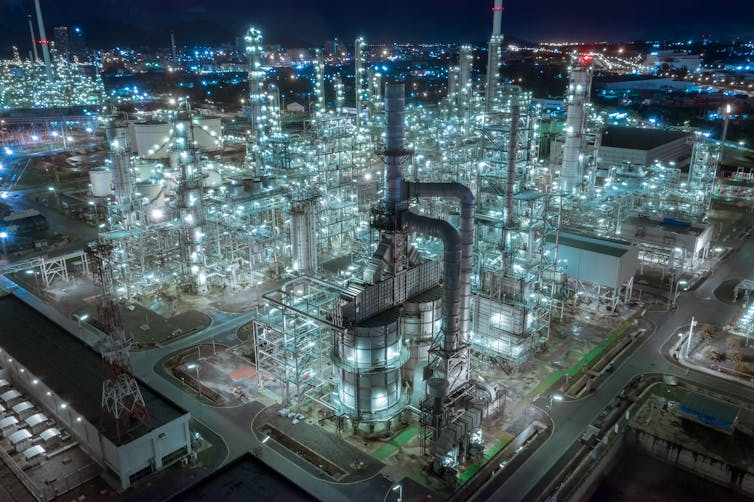
In 2016, experts writing in Nature listed seven breakthroughs in how we process chemicals that could change the world for the better. We believe we’ve just ticked one of those off the list.
We found a highly efficient and entirely novel way to separate, purify, store and transport huge amounts of gas safely, with no waste.
Why is this breakthrough so important? We believe it will help overcome the key challenge of hydrogen storage by allowing us to safely store and transport huge quantities of green hydrogen as a solid at a fraction of the energy cost. This will allow us to accelerate uptake of green hydrogen, as well as allow oil refineries to use much, much less energy, and make processing many other gases easier.
Right now, breaking crude oil into petrol and other gases in oil refineries relies on the hugely energy intensive process of cryogenic distillation. This accounts for up to 15% of the world’s energy use. By contrast, we estimate our new method would cut this energy use by up to 90%.
This method offers the world a solid storage method for gases with a far higher capacity than any previous material. The absorbed gases can be recovered via a simple heating process leaving both the gases and the powder unchanged, allowing for immediate use or re-use.

What did we find?
The breakthrough is so significant – and such a departure from accepted wisdom on gas separation and storage – that our research team repeated our experiment 20 to 30 times before we could truly believe it ourselves.
So how does it work? Our new approach uses a new method called “ball milling” to store gas in a special nanomaterial at room temperature. This method relies on mechanochemical reactions, meaning machinery is used to produce unusual reactions.
The special ingredient in the process is boron nitride powder, which is great for absorbing substances because it is so small yet has a large amount of surface area for absorption.
To make this work, boron nitride powder is placed into a ball mill – a grinder containing small stainless-steel balls in a chamber – along with the gases that need to be separated. As the chamber spins at progressively higher speeds, the collision of the balls with the powder and the wall of the chamber triggers a special mechanochemical reaction, resulting in gas being absorbed into the powder.

Better, one type of gas is always absorbed more quickly, separating it out from the others, and allowing it to be easily removed from the mill. You can repeated this process over several stages to separate out the gases you want, one by one. You can store the gases in the powder for transport, and separate them back into gas. And better still, boron nitride powder can be used to carry out the same gas separation and storage process up to 50 times.
The process requires no harsh chemicals and creates no by-products. It doesn’t require energy-intensive settings like high pressure or low temperatures, offering a much cheaper and safer way to develop things like hydrogen powered vehicles.
This ball-milling gas absorption process uses around 77 kilojoules per second to store and separate 1,000 litres of gases. That’s roughly the energy needed to drive the average electric vehicle 320 kilometres. It’s at least 90% less energy than the cryogenic distillation method used in oil refineries.
Read more: Oil companies are going all-in on petrochemicals – and green chemistry needs help to compete
That’s why we believe this breakthrough may tick off one of the seven chemical separation method improvements which could change the world – specifically, improving separation of olefin-paraffin, a key part of the petrochemical industry.
This is the culmination of 30 years work in nanomaterials and mechanochemistry by researchers at Deakin University’s Institute for Frontier Materials.
How will this help us switch to clean energy?
The gas crisis facing Australia’s east coast has drawn attention to our reliance on these fuels. In response, there have been growing calls to hasten the switch to cleaner gas fuels such as green hydrogen.
The problem is storage. Storing enormous quantities of hydrogen for practical use is very challenging. At present, we store hydrogen in a high-pressure tank or by cooling the gas down to a liquid form. Both require large amounts of energy, as well as dangerous processes and chemicals.

That’s where this method could help accelerate uptake of hydrogen, by enabling safe and efficient solid-state storage technology on a large scale. When stored as a powder, hydrogen is extremely safe. To retrieve the gas, you simply heat the powder in a vacuum.
This new process can achieve unprecedented gas storage capability, well above any known porous materials. For instance, our new process can store 18 times more acetylene than the highest uptake achieved by metal-organic frameworks, another approach using porous materials.
The remarkably high gas storage capability is due to the novel way gas molecules stick to the powder during the ball milling process, which does not break the gas molecules.
For this process to be able to scale, however, we have to perfect the milling process. There’s a sweet spot in milling which creates the weaker chemical reactions we want – without producing stronger reactions which can destroy the gas molecules. We will also have to figure out how to get the best storage rate for each material based on milling intensity and pressure of the gases.
With industry support, our novel process can be scaled rapidly to provide practical solutions to ensure we never have to face another gas crisis – and can speed up decarbonisation.
Ying Ian Chen receives funding from the Australian Research Council.
Srikanth Mateti receives funding from Australian Research Council
This article was originally published on The Conversation. Read the original article.







